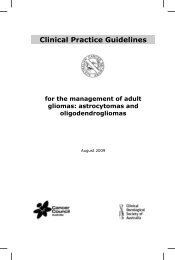Clinical Practice Guidelines for the management of locally advanced ...
Clinical Practice Guidelines for the management of locally advanced ...
Clinical Practice Guidelines for the management of locally advanced ...
Create successful ePaper yourself
Turn your PDF publications into a flip-book with our unique Google optimized e-Paper software.
3.2.2 Adjuvant systemic chemo<strong>the</strong>rapy<br />
See chapter 10 Emerging <strong>the</strong>rapies, p116<br />
3.2.3 Adjuvant androgen deprivation <strong>the</strong>rapy<br />
See section 3.1.3 Radio<strong>the</strong>rapy and androgen deprivation <strong>the</strong>rapy, p30.<br />
3.3 Node-positive disease<br />
3.3.1 Radio<strong>the</strong>rapy and adjuvant androgen deprivation <strong>the</strong>rapy<br />
The role <strong>of</strong> radio<strong>the</strong>rapy <strong>for</strong> node-positive disease is controversial. There are three RCTs containing<br />
subgroups <strong>of</strong> node-positive (primarily biopsy proven) patients that evaluate any effect <strong>of</strong> adjuvant<br />
androgen deprivation when combined with radio<strong>the</strong>rapy. Two RCTs examined radio<strong>the</strong>rapy with<br />
adjuvant ADT versus radio<strong>the</strong>rapy with ADT as a possible treatment on progression. The first, RTOG<br />
85-31, used LHRH agonist until progression 112 . The second used a non-steroidal anti-androgen <strong>for</strong> a<br />
minimum <strong>of</strong> two years. 113 The third RCT examined radio<strong>the</strong>rapy with concurrent plus adjuvant ADT<br />
(orchidectomy prior to radio<strong>the</strong>rapy) versus radio<strong>the</strong>rapy with ADT on progression. 114 The largest<br />
RCT, RTOG 85-31, was <strong>of</strong> medium quality <strong>for</strong> survival whereas <strong>the</strong> two smaller RCTs were <strong>of</strong> low<br />
quality. In all three trials <strong>the</strong> analyses <strong>for</strong> node-positive disease were unplanned subgroup analyses,<br />
increasing <strong>the</strong> risk that <strong>the</strong> arms may not be balanced <strong>for</strong> potential risk factors in this subgroup <strong>of</strong><br />
patients. The largest subgroup with 173 participants was from RTOG 85-31. The Gran<strong>for</strong>s study<br />
contained a subgroup <strong>of</strong> 39 node-positive patients and <strong>the</strong> Iversen study contained only 14 patients in<br />
<strong>the</strong>ir node-positive subgroup. 113 Radio<strong>the</strong>rapy doses were ei<strong>the</strong>r not described or varied in all studies.<br />
The RTOG 85-31 and Gran<strong>for</strong>s studies provided data <strong>for</strong> survival, prostate cancer survival and<br />
disease progression. The RTOG 85-31 study showed a trend towards improved survival with 6.5 years<br />
median follow-up. A multivariate analysis <strong>of</strong> patients <strong>for</strong> whom Gleason scores were available and<br />
which took into account Gleason score and whe<strong>the</strong>r <strong>the</strong> men had undergone radical prostatectomy<br />
found a statistically significant improvement with adjuvant ADT, with a nine-year survival rate <strong>of</strong><br />
62% <strong>for</strong> adjuvant ADT versus 38% <strong>for</strong> radio<strong>the</strong>rapy alone. The smaller Gran<strong>for</strong>s trial with a median<br />
follow-up <strong>of</strong> 9.3 years showed a statistically significant survival benefit <strong>for</strong> immediate orchidectomy<br />
with a nine-year survival rate <strong>of</strong> 50% <strong>for</strong> immediate orchidectomy <strong>the</strong>rapy versus 13% <strong>for</strong><br />
radio<strong>the</strong>rapy alone. 114 Similar results were found <strong>for</strong> prostate cancer mortality. With longer follow-up<br />
to 19 years, this survival benefit was maintained. 115 The Iversen study had reduced rates <strong>of</strong> clinical or<br />
biochemical progression with anti-androgen <strong>the</strong>rapy in <strong>the</strong>ir very small subgroup <strong>of</strong> men. 113<br />
Isolated biopsy proven node-positive disease represents a relatively small cohort <strong>of</strong> prostate cancer<br />
patients. In <strong>the</strong>se patients <strong>the</strong>re is potential <strong>for</strong> a major survival benefit with androgen deprivation in<br />
addition to radio<strong>the</strong>rapy. However it is not known whe<strong>the</strong>r adding radio<strong>the</strong>rapy to androgen<br />
deprivation <strong>for</strong> node-positive patients provides any benefit.<br />
Only one <strong>of</strong> <strong>the</strong> three RCTs, RTOG 85-31, examined radio<strong>the</strong>rapy toxicity outcomes <strong>for</strong> adjuvant<br />
ADT–in this trial LHRH agonist <strong>the</strong>rapy–<strong>for</strong> <strong>the</strong> node-positive patient subgroup.<br />
The authors reported that <strong>the</strong> incidence <strong>of</strong> grade 3 and 4 acute and late toxicities was not statistically<br />
significantly different.<br />
As long-term adjuvant androgen deprivation as an adjuvant to radio<strong>the</strong>rapy appears to improve <strong>the</strong><br />
survival <strong>of</strong> men with biopsy node-positive prostate cancer, no evidence <strong>of</strong> increased radio<strong>the</strong>rapeutic<br />
toxicities would have a substantial clinical impact. However, <strong>the</strong> hormone-associated toxicities that<br />
would have an impact on quality <strong>of</strong> life were not assessed, reducing <strong>the</strong> clinical impact.<br />
One trial reports no difference in grade 3 and 4 toxicities with LHRH agonist treatment after<br />
radio<strong>the</strong>rapy. O<strong>the</strong>r known toxicities <strong>of</strong> hormonal <strong>the</strong>rapy were not reported. 112<br />
<strong>Clinical</strong> practice guidelines <strong>for</strong> <strong>the</strong> <strong>management</strong> <strong>of</strong> <strong>locally</strong> <strong>advanced</strong> and metastatic prostate cancer<br />
38



